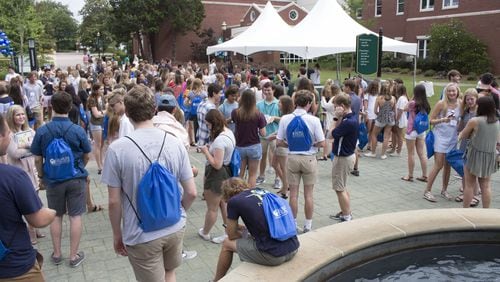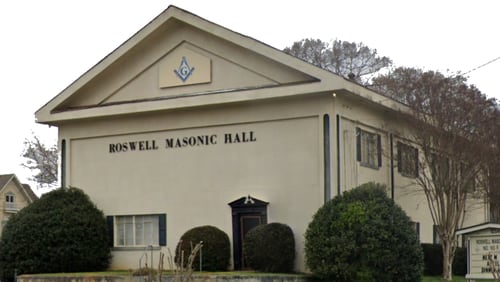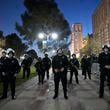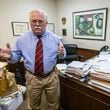The mother and son made the three-hour trip from Greenville, S.C., to Milledgeville on a recent Friday morning to see the college campus the young man will soon call home.
Georgia College & State University’s selling points included friendly employees and a scenic campus, said Sylvia Grieco and her son, Alex, 18. But there was something else mom said was important that the school offered: a liberal arts education that “can prepare him for the real world.”
The mother said she knew some people who excelled academically in college but “couldn’t get a job because they didn’t know how to interview.”
There are indications that liberal arts education nationally — through which students learn about the arts, humanities and sciences and get degrees in those fields — is in trouble. Many educators nationwide have debated the future of liberal arts colleges and education as dozens of schools have closed or merged in recent years, bowing to the increased demand of students and parents in search of specialized college educations in higher-paying business and technological industries.
In Georgia, however, several colleges and education leaders have recently vowed to increase their liberal arts offerings, saying the skills students learn in the courses — how to think critically, write clearly and ask good questions — more than adequately prepare graduates for any career. University System of Georgia Chancellor Steve Wrigley in April outlined the importance of liberal arts education in the 325,000-student system. Six USG institutions, including Georgia College, are involved in a national effort to link skills through liberal arts curriculum to the demands of a global job market.
Alex’s mother appreciated the college’s awareness of graduates eventually entering careers. For example, Georgia College, since 1996 the state’s officially designated public liberal arts university, offers interviewing workshops and even instruction in how to shine during a business dinner — the “soft skills” many employers say they’re looking for in employees.
But liberal arts advocates cite benefits way beyond interview skills. That kind of education can teach students career-ready skills such as leadership, teamwork, communication, problem-solving and creativity, said Xiaodan Hu, an assistant professor at Northern Illinois University who wrote a review last year on liberal arts enrollment.
In May, Emory, the state's largest private university, announced plans to advance itself as "a leader for the liberal arts and sciences" by developing a recruitment program for postdoctoral scholars working on emerging, interdisciplinary topics and recruiting emerging artists through national and international fellowships.
Spelman College, consistently ranked by some national publications as one of the state’s top liberal arts colleges, is developing an “innovation curriculum” to build a partnership between their liberal arts disciplines with competencies in technology and digital media. It’s also elevating its art history program from a minor to a major. Both initiatives are scheduled to be in place by 2019.
“So far from running away from the liberal arts, Spelman is sprinting toward it” said its provost, Sharon Davies.
Georgia College’s president, Steve Dorman, has a similar viewpoint. “We’re owning it,” he said of liberal arts during an interview in his office.
There are about a dozen liberal arts colleges in Georgia. Most are small (less than 2,500 students) and have religious affiliations. Other metro Atlanta liberal arts schools include Agnes Scott College, Morehouse College and Oglethorpe University.
In recent decades, though, more students and their parents have sought more specialized higher educations as the cost of college and student loans skyrocketed and the growth of technology companies required more workers well-versed in coding instead of Latin.
Fewer than one in 20 of all degrees now are in humanities disciplines traditionally associated with the liberal arts, according to the American Academy of Arts & Sciences. That’s down from a high of nearly one in five in 1967. A 2017 Metro Atlanta Chamber report found there are more degrees in liberal arts and similar areas than demand calls for and far from enough health care and business degree recipients to fill available jobs.
Smaller, private liberal arts colleges, ill-equipped to provide the computer science and technology courses more students wanted, have had the most trouble. Morris Brown College, near downtown Atlanta, had its accreditation revoked in 2003, but is still operating with about 55 students.
In response to the enrollment and degree declines, many liberal arts colleges shifted their focus toward vocational education and reduced liberal arts degrees, said Hu, at Northern Illinois.
“I think it is more urgent for liberal arts colleges to re-examine their mission statement and whether their academic programs are in alignment with what they are committed to,” Hu said in an interview. “This understanding of ‘who, what, and how’ should be clearly communicated among stakeholders, including faculty, administrators, and students. Emphasizing and reaffirming the institutional mission has a significant meaning in justifying institutional legitimacy and claiming a unique identity.”
Michael Elliott, the dean of Emory’s College of Arts & Sciences, said many students misunderstand the value of liberal arts education.
“Honestly, I think some of that is on us,” Elliott said of the industry’s communication.
Elliott said the May announcement was partly an effort to “articulate clearly and boldly that we believe the liberal arts are still a part of the landscape of higher education.” Emory’s strategy includes more support for undergraduate research. Aspiring business students need to have the equivalent of two years of academic credit through the College of Arts & Sciences or Oxford College, which has a liberal arts and sciences curriculum, before entering the undergraduate business program.
Elliott believes the thinking skills emphasized by liberal arts colleges are an important foundation for workforce skills, noting some popular jobs didn’t exist a decade ago.
“Everything we know about the world of work in the future is that we don’t know,” said Elliott, who studied English and American history in college.
Elliott and others think more students are getting it. The university said the number of applicants to its College of Arts & Sciences has increased from 20,000 two years ago to about 27,000 last fall. At Georgia College, officials say more students are applying there and the academic credentials of incoming freshman are improving. This fall’s freshman class has a 3.58 average grade-point average and 1218 SAT score (1600 is the highest possible score).
Georgia College’s leaders have focused on teaching students career skills through its “GC Journeys” program, which requires students to have what it describes as two transformative experiences, such as studying abroad or an internship, before graduation.
“We are preparing students better for an uncertain future,” the college’s provost, Kelli Brown, told Grieco and about 300 parents during that day’s opening orientation session.
Many liberal arts colleges in Georgia now have detailed four-year plans for students with smaller class sizes, one-on-one career counseling and mentoring from business professionals to draw students and prepare them for careers.
Rob Betzel, the chief executive officer of Infinity Network Solutions, a Macon-based information technology company, is one of those mentors. Betzel, a 1999 Georgia College graduate, has hired several dozen students from his alma mater and said he spends lots of time on campus helping prepare them for the work world through mock interviews.
These are skills, he insists, that could only come from a liberal arts college.
“The sociology, the psychology I took has impacted what I do in a technical field,” said Betzel, who earned a business degree from the college.
Betzel’s company requires new employees to read six books during their first nine months on the job as part of the company’s effort to make sure the workers have the necessary critical thinking skills and judgment to thrive.
Incoming Georgia College freshman Amy Stanton said she chose the school to develop those skills. Stanton, 17, from Cobb County, is considering a career in international business, wants to be in a college environment where she can learn from students from other backgrounds.
“The world is my oyster,” she said. “I can do whatever I want.”
These are the five liberal arts majors with the highest number of graduates in 2015, the most recent year available, and the median salary for graduates younger than 35.
Degree graduates median salary
1) psychology 448,864 $35,750
2) communications 373,736 $41,600
3) English 226,034 $38,710
4) political science and government 222,762 $43,730
5) economics 219,289 $52,450
Source: U.S. Bureau of Labor Statistics
Here are the five fields of study with the largest increases in graduates between the 2011-12 and 2016-17 school years:
1) health professions 59.6 percent
2) computer and information systems 49.6 percent
3) parks, recreation and leisure studies 41.7 percent
4) engineering 39.9 percent
5) math & statistics 32.6 percent
Source: The National Center for Education Statistics
About the Author







